Get a New Laptop With Intel Evo Technology for as Low as $800

Lenovo ThinkPad X1 Titanium Yoga review: The executives showoff laptop
In a time where everyone is roughly their own independent contractor while working from home, the Lenovo ThinkPad X1 Titanium Yoga offers an executive experience like very few laptops can.
The Lenovo ThinkPad X1 Titanium is a flossy silver notebook that weighs less than any other previous or current ThinkPad laptop and that includes the newly released Nano. As such, the X1 Titanium is patently designed to be used by the more mobile employee who's often in meetings, doesn't need bleeding edge processing and who might weigh presentation over productivity.
I've likened the X1 Titanium to the executive laptop for all of the above considerations as well as its price. Coming in at $1,769.40, the X1 Titanium isn't being made for the cubical jockey or even the mid-level manager with a propensity for self-entitlement. The X1 Titanium is an executive laptop through and through.
The new X! Titanium carries the same branding as other ThinkPads and for most durability standards achieves a similar hardness to its exterior as its thicker laptop cousins.
However, the immediate departure from matte black to the more noticeable Titanium colored lid denotes a conspicuous effort to stand out from the crowd.
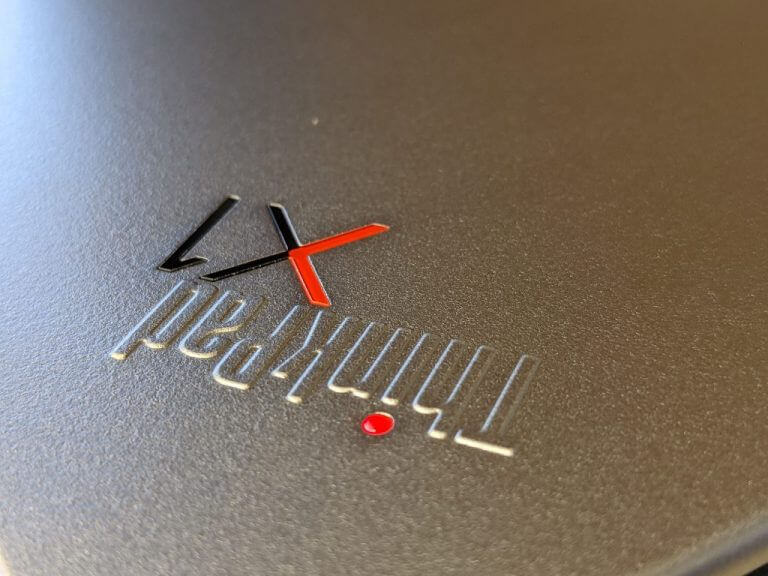
Couple the visual distinct color scheme of the Titanium and its ultra-portable weight of 2.5 pounds, the X1 Titanium isn't meant to simply rest on a desk or homogenize with the average desktop setup.
A noticeable caveat is that the X1 Titanium has way more flex to the chassis than other ThinkPads which appears to be a result of the lightweight materials used in its construction.
Fortunately, the X1 Titanium isn't just a pretty package, it packs most the accoutrement needed for productivity as well as ushering in the much needed 3:2 display aspect ratio for optimized productivity.
Look and FeelThe X1 Titanium is a Lenovo Yoga class laptop which means its screen can be folded back close to 360-degrees of rotation. While I've found the Yoga branding and marketing to be more a tangential feature of Lenovo's laptops, the Titanium's incredibly reduced weight had me using its 'tablet mode' more often than I've done on any other Yoga-like device in the past.
The keys are still readily present when holding it in tablet mode and will always seem to take some getting used to but once that is overcome or at least acknowledged, using a 13.5-inch Windows tablet can be pretty useful.
At 13.5-inches and sporting a 3:2 aspect ratio with anti-reflective and anti-smudge technology allowed me to view more web content in both desktop and tablet modes when pairing windows side by side.
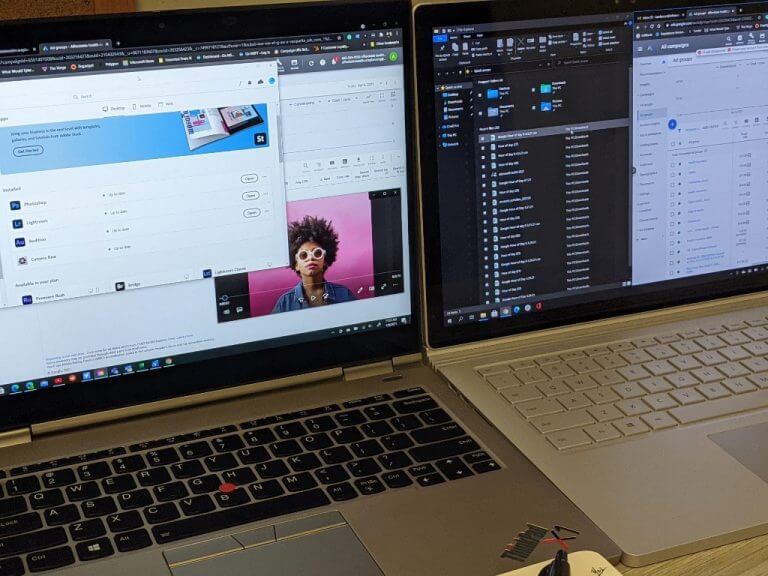
The executive who spends 2/3 of their day triaging emails, PDF's and Excel reports, the Titanium's elongated display ratios will be much appreciated. In addition, the 450 nits of brightness (indoors) should help with eye strain as well as its QHD resolution which comes out to 2,256 v 1,504 pixels.
Unlike other ThinkPads, the Titanium has a textured tactile lid that is very different than the chalkboard-like feels you get from other ThinkPads. The lid of the Titanium feels bumpier than previous Thinkpads, and as such, offers a grippier feel in hands.
Moving beyond the exterior, the Titanium packs the infamous 11th Gen Intel Core processors with configurations up to an i7 vPro and is crafted alongside Intel's new Evo platform standards.
Once again, the inclusion of a vPro enabled processor makes its top choice for Fortune 500 companies who may look to deploy these laptops to the top brass who weed through mountains of macros-enabled Excel sheets or 80+decks of PowerPoint proposals or presentations.
The model I reviewed was spec'd out at 16GB of LPDDR4X 4267MHz memory and 512GB of PCIe storage.
While I was able to squeeze out the same sort of performance, I normally get with most other ThinkPads, another reason I equate this device to executive arm candy is its limited port selection. Similar to a MacBook, the Titanium only offers 2 Thunderbolt 4 ports, a Kensington lock slot and a headphone/mic combo and that's it.
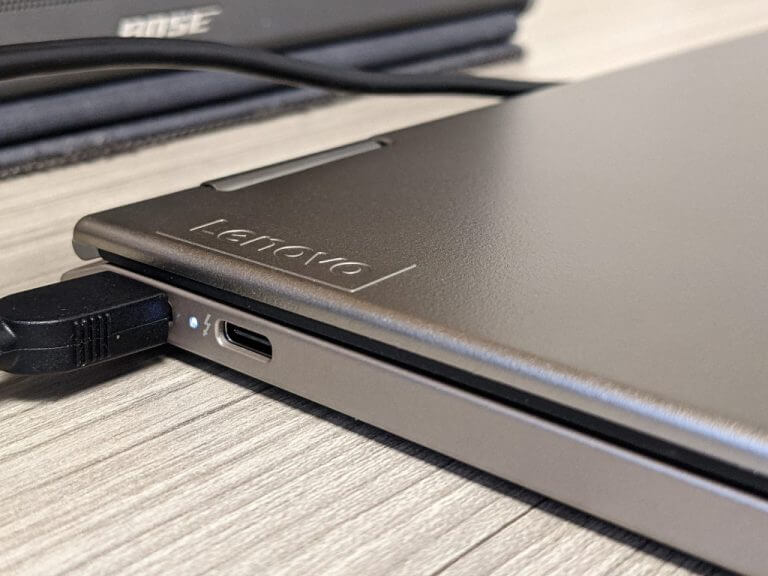
Most productivity workers tend to need USB-A and HDMI ports from a device that's powering their daily workstation. Yes, dongles and adapters can be used and, in fact, I used many, but its normally the executive whose connectivity needs are as limited as the Titanium's.
In addition to its limited port selection, the Titanium sacrifices the familiar keyboard tactical feel. Key travel is capped at 1.35mm and is noticeably different than that of other ThinkPads but it's definitely passable, but not for extended amounts of time.
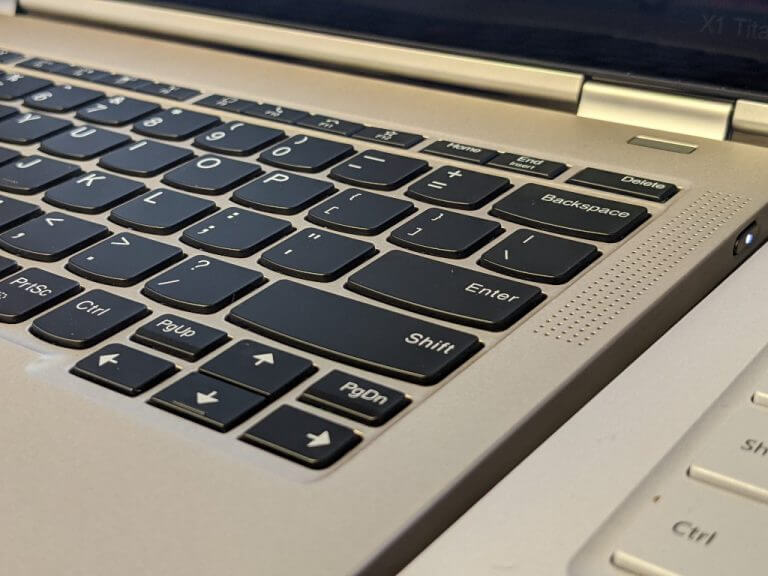
As my day job, I work in marketing so I have a hybrid management and cubicle workflow so I was able to enjoy the benefits of the power packed into the ThinkPad X1 Titanium as well as its focus on portability. Unfortunately, in its efforts to market its wafer-thin design, its airflow suffers and as a result, it comparatively comes up short to similar competitors.
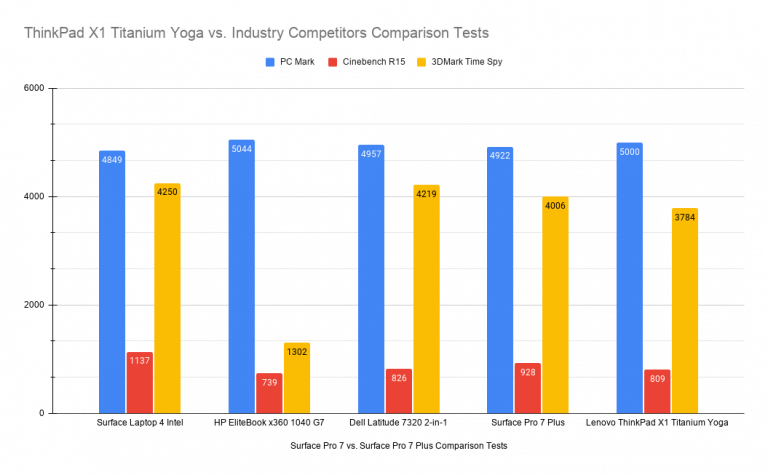
When testing generic content-creation workflows, the X1 Yoga holds it owns against some of the best, with its easily scoring above 4,000 in the PCMark benchmarks. The PCMark benchmark synthetically test items such as word processing, spreadsheet triage, web browsing, and the all-important video conference.
When it comes to stressing the CPU and the cores to render complex images, it's a step above the HP Elitebook but comes in fourth among its competitors. Cinebench R15 does negate some of the gains in GPU performance that Intel's 11th gen chip boots, but with all things being equal the CPUs are relatively the same across the board and the X1's performance may be due to throttling that happens when the fans kick up on the device.
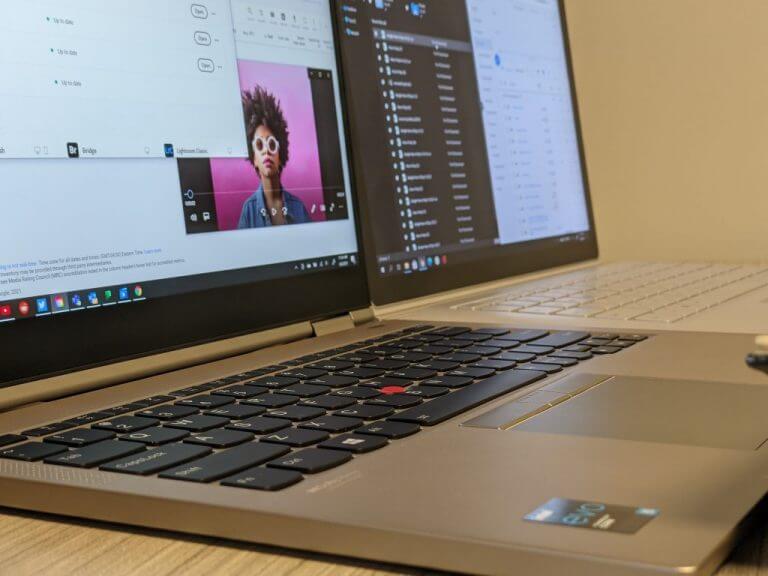
It should be noted, none of the devices tested are gaming PCs but most can used for an extremely casual video game experience. Thanks in large part to the Iris Xe Graphics processor from Intel, the Surface devices performed slightly better but the X1 can be used to play games such as State of Decay 2, Wasteland 3, Red Dead Redemption 2 on super low settings for a couple of hours.
As for battery comparisons, the HP Elitebook outlasted all devices at 19:02 hours and the X1 Titanium Yoga came up second to both Surface devices which lasted over 14 hours a piece. The X1 Yoga does a decent job at a smidge over 14 hours in a battery drain test, but when working on devices full time, screen time on the Titanium Yoga topped out at just under 12 hours and the Surface lasted over 12 hours.
SummaryAs I said before, the Titanium is a ThinkPad for the most part but in its pursuit of more casual features it differentiates itself from its cousins in ways that feel excessively premium. The reduced weight is appreciated but at the sacrifice of a familiar typing experience, quicker throttling of the CPU, tiny audio (the drivers are limited in space presenting a tinny auditory experience), and flex in the chassis, the X1's tradeoffs feel better suited for a highly productive executive than a content creator, coder, or process professional.
The gorgeous new HP Omen 16 gaming laptop is bigger, better, and faster

HP has announced several products in its Omen gaming line, including the brand new HP Omen 16 gaming laptop. It’s a redesign of the HP Omen 15, updated now with a larger, better screen, the latest hardware under the hood, and some tweaks to the overall look.
Other announcements include an updated Omen 17, a new midrange gaming laptop brand called HP Victus, and a new 25-inch Omen gaming monitor.
HP Omen 16 and 17
The primary feature of the HP Omen 16 is the larger 16.1-inch screen, which HP says it has fit into the size of a standard 15-inch chassis. It has up to a QHD (2560 x 1440) 165Hz screen with a 3ms response time, matching some of the very best gaming screens from laptops like the Razer Blade 15 and MSI GS66 Stealth. Of course, 1080p panels are also available in the more affordable configurations.
Surrounding the display are some fairly thin bezels, though the bottom chin is still rather larger. Under that bottom bezel is a new hinge, which HP calls a “floating display.”
Other aspects of the laptop, such as the per-key RGB keyboard, full-sized arrow keys, and large touchpad, are unchanged from the previous Omen 15.
HP offers either an Intel or AMD processor, paired with your choice from the Nvidia RTX 30-series, up to an RTX 3070 for a total of 115-watts. On the Intel side, you’ll get up to an 11th-gen Core i7-11800H, while the AMD configurations can be scaled up to the Ryzen 9 5900HX.
HP is also offering a mysterious RDNA 2-based AMD graphics card on the Omen 15, though the company hasn’t provided any details yet.
The Omen 17, on the other hand, is what HP calls its “desktop-like” gaming laptop. It’s bigger and larger, obviously, though the chassis has been slimmed down slightly from last year’s model. It is 8% smaller in overall volume and 10.7% thinner this time around.
The Omen 17 otherwise looks very similar to the Omen 16, using a lot of the same design features and stylings. The keyboard is different though. Whereas the Omen 16 features standard rubber dome keys, the Omen 17 opts for optical switches, which give it a 0.2ms response time and 1.7mm of key travel. The result should be a far more tactile keyboard.
Inside, the Omen 17 has options for up to an Nvidia RTX 3080. Reserving the high-end GPU for the larger laptop is a simple way of distinguishing the two, but it also ensures that HP can give that power-hungry graphics card as much airflow as possible.
Both systems have made some changes to feature a new thermal system under the hood, known as Omen Tempest Cooling Technology. They both use a new fan that’s two and a half times thinner than the Omen 15, allowing for twice as many fan blades. Between the new fans and the increased ventilation, HP says the Omen 16 will run 3.2 degrees Celsius cooler than before, while the Omen 17 is 5 degrees cooler.
That’s important when you consider the maximum of 165 watts of total power that can be delivered to the RTX 3080.
The AMD version of the Omen 16 starts at $1,050, and the Intel model starts at $100 more. Meanwhile, the Omen 17 starts at $1,370. All the new Omen laptops will be available starting in June.
HP Victus
HP also announced an entirely new line of gaming laptops, under the brand name “Victus.” It sits in between the budget-level HP Pavilion gaming systems and the flagship HP Omen, in terms of pricing, performance, and design.
These Victus laptops have an entirely new industrial design and brand, which will undoubtedly be confusing for gamers trying to choose between this and Omen. The design isn’t quite as clean or sleek, and the system is a bit clunkier as well. Not as bad as the Pavilion laptops, of course, but again, these Victus laptops sit somewhere in between.
The first laptop to launch in the Victus line is a 16-inch gaming laptop.
It features a large touchpad, plenty of ports, and a number pad off to the right.
It’ll also be confusing to know which of these laptops to buy based on performance too, as the Victus laptops can be configured up to an Nvidia RTX 3060, which crosses into Omen territory in terms of performance. It can also go down as low as the MX450, which is almost not enough graphics power to be considered a gaming laptop. Although HP says the Pavilion laptops will continue to be supported, the Victus laptops certainly seem to tread in similar territory.
Of course, the Victus 16 gaming laptop comes with options for a Core i5 or Core i7 11th-gen Intel processor. However, you can also go all-in on AMD, offering both Ryzen 5000 processors and up to an RX 5500M graphics card.
You can even opt for a 1440p display with up to a 165Hz refresh rate.
The AMD version of the Victus 16 will start at just $800 and will launch in June. Meanwhile, the Intel version will start at $850.
AMD Advantage Laptops Deliver A Powerful Gaming Experience Through a Design Framework
Last week, I tuned into the annual Computex 2021 event, held in Taipei, Taiwan. A must for anyone involved in the PC sector, this computer expo is one of the biggest, most well-attended trade shows on the planet.
Manufacturers of PCs and computing components come from worldwide to show off their latest and greatest, often seizing the occasion to announce new products and technology. AMD made a big splash at the event this year, taking a run at gaming primacy with a new notebook design framework, new laptops and new graphics technology.
Let’s take a look at what AMD’s Frank Azor announced at the show.
Introducing AMD Advantage
I believe the biggest story from AMD’s Computex show was the new AMD Advantage Design Framework, the fruits of an effort between gamers, AMD engineering and its PC partners to develop “the next generation of premium, high-performance gaming laptops.” I don’t say this lightly as AMD hit some huge Computex home runs like FSR, Tesla Model S and X wins and the disclosure that Samsung is using RDNA2 which includes ray tracing for mobile devices.
The first AMD Advantage laptops, HP’s Omen 16 and Asus’s ROG Strix G15, should arrive this month, showcasing the impressive performance, graphics and immersion AMD claims Advantage will enable for gamers. While these will be the first computers out of the gate, AMD shared that laptops from MSI and Lenovo will be coming later in 2021.
The notebook gamer conundrum – the fiddler crab
For many notebook gamers, selecting the right gaming notebook is a challenge. There are a sea of specifications out there and sometimes going just all-in on one aspect of a design will harm another element of the experience. It’s like a fiddler crab with one giant claw.
For instance, you can configure a highly-performant notebook that burns fingers as you’re playing a game. If you don’t think enough about the display you could have stuttering and tearing. Some gaming notebooks skimp on battery size and life and you can’t watch a full movie if you wanted to. My “favorite” is slow storage on gaming notebooks that take an eternity to load a game or shift from scene to scene. If you make a mistake with on specifying your gaming laptop, there’s no turning back- you’re stuck. This is different from a gaming desktop where components are mix and match.
I don’t blame OEMs for this as a very technical shopper knows better, but every gamer isn’t a surgical shopper or know the design trade-offs.
The framework
The framework essentially works like this: AMD does primary research on gamers to find what they prefer and consults with OEM partners in selecting the right discrete GPU, CPU, display and other necessary hardware components for their gaming laptops.
Premium displays, naturally, are crucial for high-end gaming laptops, and AMD has made this a priority. AMD Advantage laptops will feature tip-top 144HZ-plus displays with extreme low-latency, AMD FreeSync technology, IPS and OLED panels, 300-plus nits brightness, and 100% SRGB or 72% NTSC.
Additionally, AMD is promising 100 FPS gaming experiences at 1080P, over 10 hours of video playback on a battery charge and speeds up to three times faster due to their NVMe storage drives.
New graphics to boot
At the heart of the AMD Advantage line, including the two noted above, is another new announcement—AMD’s Radeon RX 6000M Series Mobile Graphics. AMD built these new graphics offering upon its (also new) RDNA 2 gaming architecture, which AMD says delivers 1.5X better performance than the previous generation RDNA or use as much as 43% less power, at the same performance level of the previous generation.
An aside: RDNA 2 is also the foundation of the next-generation PlayStation 5 and Xbox Series S and X consoles.
The 6000M Series comes with a bevy of new, compelling features. Take the AMD Infinity Cache, which cuts latency and power consumption by integrating as much as 96MB of last-level data cache into the GPU die. AMD’s Smart Access Memory, also included, enables select AMD-based laptops to achieve even better performance by giving their Ryzen processors full access to AMD’s Radeon GDDR6 graphics memory.
AMD SmartShift Technology dynamically toggles laptop power between the Ryzen chips and the graphics, optimizing resources to give the laptop a helpful boost of performance. Radeon Chill, meanwhile, monitors in-game movements and regulates frame rates accordingly, which AMD says gives the 6000M series an extension of battery life.
The last new feature of the 6000M series that I’ll note is FidelityFX, an open-source toolkit of graphics enhancement effects. Available through AMD GPUOpen, game developers can access rasterized lighting, reflection and shadow effects and more. Perhaps most exciting is that it features AMD’s new FidelityFX Super Resolution, or FSR, which gives gamers four different options for balancing image quality and performance, depending on their wants and needs.
AMD says that FSR supports ray tracing and other performance-intensive effects. For that matter, it’s purportedly capable of delivering as much as twice the framerate for select games and as much as 2.5X as much 4K performance when engaging the “Performance” setting, thanks to its optimized spatial upscaling technology. All of this is possible through the FidelityFX toolkit, which means that you may not even have to update your graphics card to access these benefits.
I’ll be writing more on FSR in the future and one thing I love is that it seems easy for developers to embrace versus other image quality enhancer solutions. AMD’s approach reminds me of FreeSync that was easy to implement, didn’t raise cost and ended up being pervasive.
Wrapping up
Experience-based notebook implementations like Intel’s Evo and AMD Advantage for gamers are positive things for the industry. Evo is focused on mobile professionals and AMD Advantage is the first and only design framework like this for notebook gamers.
I believe discerning gamers want the combination of great performance, great display, and quality design to deliver a great experience. But researching and choosing the right gaming laptop is a confusing endeavor to many. With the AMD Advantage design framework, I believe gamers will save time researching and lower their purchase risk. I believe AMD can architect a more effective framework as it has its own gaming processor, graphics, and software stack and enable OEMs to bring their vision to life.
I applaud AMD for helping notebook gamers and making sure it wasn’t a toothless sticker and marketing program. First generation programs are never perfect and AMD Advantage will likely have some improvements with more teeth next round, but this is a very good first step. I can’t wait to get my hands on one later this month and see for myself.


0 Comments
Nice